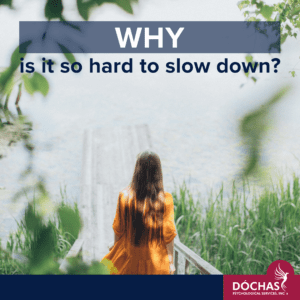In today’s fast-paced world, the idea of slowing down can feel like a luxury – one that many of us struggle to afford or even allow ourselves to experience. Whether it’s work, social obligations, or the endless stream of digital distractions, letting ourselves slow down often feels counterintuitive.
Why is it so hard to hit the brakes and allow ourselves the space to simply be? It’s Pooja on the blog – the answer lies deep within our nervous system and can be better understood through the lens of somatic experiencing.

The Nervous System: Wired for Action
Our nervous system is an intricate network designed to keep us alive and functioning. It plays a critical role in how we perceive and react to the world around us. One of its primary functions is to assess threats and prepare us to respond – whether that means fighting, fleeing, or freezing. This response, known as the fight-or-flight reaction, is deeply ingrained in our physiology and has been crucial for human survival.
However, in our modern world, the threats we face are often more psychological or social than physical. Yet, our nervous system reacts similarly to these modern-day stressors as it would to physical danger. Whether it’s a looming deadline, an overwhelming to-do list, or the constant bombardment of information, our nervous system is frequently on high alert, driving us to keep moving, keep doing, and keep responding.
The Challenge of a Hyper-Aroused Nervous System

When our nervous system is in a state of hyper-arousal, it can be incredibly difficult to slow down.
Hyper-arousal occurs when our sympathetic nervous system, the part responsible for the fight-or-flight response, is chronically activated. This can happen due to prolonged stress, unresolved trauma, or even the cumulative effect of daily stressors. When we’re in this state, slowing down can feel almost impossible because our body has been wired to keep going as a means of survival.
This is why many people find it challenging to sit still, meditate, or even sleep soundly – their nervous system is still in “go” mode, even when they’re trying to slow down.
Somatic Experiencing: Understanding the Body’s Need for Speed

Somatic experiencing, a therapeutic approach developed by Dr. Peter Levine, offers valuable insights into why it’s so hard to slow down. This approach focuses on the body’s experience of trauma and stress, and how these experiences are stored in the nervous system.
According to somatic experiencing, when our body encounters stress or trauma, it may not fully process the experience, leading to a build-up of energy in the nervous system. This unprocessed energy can manifest as a constant need to stay busy, to keep moving, or to avoid stillness.
For instance, if someone has experienced chronic stress or trauma, their nervous system may become stuck in a state of hyperarousal. This person might find it difficult to slow down because their body is still carrying the unresolved energy of past experiences. Slowing down, in this case, might feel uncomfortable or even threatening because it requires the nervous system to confront and process this stored energy.
The Cultural Push to Stay Busy
Beyond our individual nervous systems, there’s also a cultural aspect to consider. Many societies, particularly Western ones, place a high value on productivity, achievement, and constant activity. This cultural norm reinforces the idea that slowing down is equivalent to laziness or inefficiency. When we internalize these values, it can be even harder to allow ourselves to rest, as we might feel guilty or anxious about not being “productive.”
Strategies to Slow Down

The next step to living a more calm life is to actively engage in practices that can help relax the nervous system and create space for rest.
Here are a few strategies:
1. Body Awareness:
Begin by tuning into your body and noticing the physical sensations that arise when you try to slow down. Are there areas of tension or restlessness? By bringing awareness to these sensations, you can start to understand what your body is communicating and address it with compassion.
2. Breathing Exercises:
Slow, deep breathing can help activate the parasympathetic nervous system, which is responsible for rest and relaxation. Practice deep breathing exercises, such as diaphragmatic breathing, to help shift your nervous system out of hyper-arousal.
3. Gentle Movement:
Sometimes, the transition from activity to rest needs to be gradual. Engage in gentle, mindful movements such as yoga, tai chi, or walking to help your body slowly unwind and prepare for rest.
4. Progressive Muscle Relaxation:
This technique involves tensing and then relaxing different muscle groups in the body. It can help release physical tension and signal to your nervous system that it’s safe to slow down.
5. Create Boundaries with Technology:
Our devices keep us in a state of constant stimulation. Set boundaries around your use of technology, especially before bed, to give your nervous system a chance to decompress. Instead, try spending some time outside in nature (it has proven health benefits!).
6. Cultivate Stillness in Small Doses:
If slowing down feels overwhelming, start with small doses. Take a few moments to sit quietly, practice mindfulness, or simply do nothing. Gradually increase the amount of time you spend in stillness as your nervous system adjusts.
Embracing the Challenge
Slowing down is not easy, especially in a world that rewards constant motion. However, by understanding the role of the nervous system and incorporating practices that support relaxation, you can begin to create space for rest and recovery. Remember, slowing down is not about doing nothing—it’s about giving your body and mind the time they need to process, heal, and restore. Embrace the challenge, and allow yourself the grace to move at a pace that honours your well-being.
If you have any questions about slowing yourself down, please reach out to Dóchas at 780-446-0300 or info@dochaspsych.com. Book an in-person or virtual appointment with one of our therapists here.
About Dóchas Psychological
Dóchas Psychological Services is a well-established and trusted therapy clinic located in Spruce Grove, Alberta. At Dóchas we value the idea that everyone deserves a safe space. Through connection and education, our team works hard to build a trustworthy relationship with each of our clients. It is our goal to create a community for our clients to feel like they belong.
Disclaimer
Information provided through Dóchas Psychological Services blogs or vlogs is meant for educational purposes only. They are NOT medical or mental health advice. You can read more about our disclaimer here.









